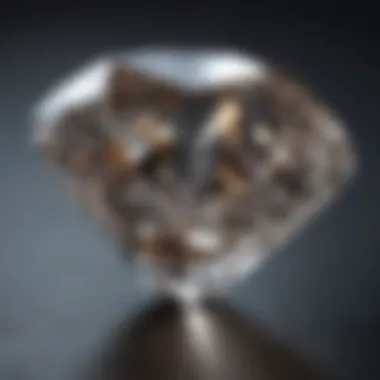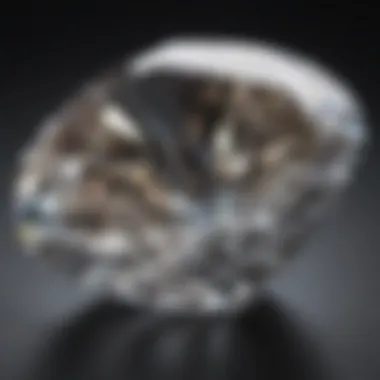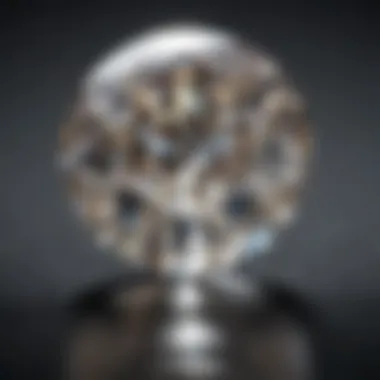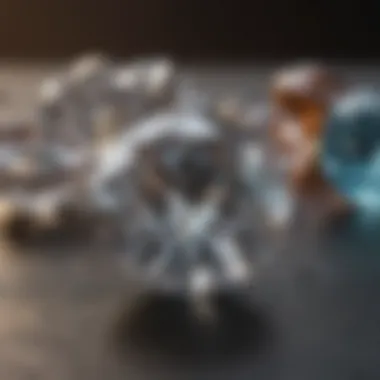How to Identify Authentic Diamonds: A Complete Guide


Intro
Understanding how to discern genuine diamonds from imitations is invaluable for enthusiasts and collectors alike. The marketplace is filled with various stones, some of which may closely resemble a true diamond. This comprehensive guide aims to provide an intricate look at diamonds, detailing their attributes, properties, and the key techniques for thorough evaluation.
In this article, we will explore the essential characteristics that define real diamonds, the different categories of gemstones, and the specific properties that set diamonds apart. With a focus on the expertise found in the industry, you will gain insights that are both practical and informative. Together, we will also navigate the nuances of the diamond market, which contributes to making an informed purchase. By the end of this guide, you should feel equipped to make confident decisions when assessing the authenticity of diamonds.
Understanding Diamonds
Understanding diamonds is crucial for anyone interested in discerning real diamonds from imitations. This section establishes the foundational knowledge necessary for making informed decisions about diamond purchases. Without a grasp of what defines a diamond, one may easily confuse genuine stones with less valuable alternatives. This guide aims to highlight the elements that contribute to a diamond's authenticity, value, and significance. By having a solid framework about diamonds, enthusiasts, collectors, and jewelers can communicate effectively and make choices that align with their values and preferences.
Definition and Composition
A diamond is a crystalline form of carbon, known for its unique optical and physical properties. Diamonds form under high-pressure and high-temperature conditions in the Earth’s mantle. Their structure consists of a three-dimensional arrangement of carbon atoms, which gives them their unparalleled durability and brilliance. The composition plays a key role in a diamond's characteristics. Notably, even minor impurities can affect the stone's clarity and color. Understanding this composition helps buyers appreciate the value of a diamond and discern quality differences among various stones.
History of Diamond Use
The allure of diamonds dates back thousands of years. They have been used in jewelry and as symbols of power and wealth across cultures. In ancient India, diamonds were valued for their physical properties, believed to provide protection against evil. Over time, diamonds gained popularity in European aristocracy, especially after they were introduced by traders. The 19th century marked a significant turning point with the discovery of diamond mines in South Africa, leading to mass production and availability. Today, diamonds are integral to various cultural and commercial practices, including engagement rings and fashion jewelry.
Cultural Significance
Diamonds hold extensive cultural significance worldwide. In many societies, they symbolize love, commitment, and status. For example, the tradition of giving a diamond engagement ring became commonplace in the 20th century, rooted in marketing campaigns that emphasized their rarity and beauty. Furthermore, diamonds are often linked to various rituals and traditions, enhancing their emotional and symbolic value. Their presence in art, literature, and film also showcases their enduring influence over time. Understanding this background can enrich one’s appreciation of diamonds beyond their aesthetic appeal.
The Four Cs of Diamonds
Understanding diamonds' inherent quality is crucial for anyone interested in purchasing or evaluating them. The Four Cs—Carat Weight, Cut Quality, Color Grading, and Clarity Evaluation—serve as the primary metrics for assessing a diamond’s value and authenticity. These criteria not only help buyers make informed decisions but also ensure sellers present their diamonds accurately. An appreciation of the Four Cs allows enthusiasts and collectors to engage with diamonds on a deeper level, leading to more gratifying purchase experiences.
Carat Weight
Carat weight is often the most well-known characteristic of diamonds. Carats measure the weight of the diamond, with one carat equaling 200 milligrams. While larger diamonds are generally more valuable, the relationship between carat weight and price is not linear. A half-carat diamond can be significantly less expensive than a full-carat diamond due to market demand and availability. It’s essential to consider the overall quality alongside size. A smaller diamond with superior cut, color, and clarity may outshine a larger diamond of lesser quality.
Key points about Carat Weight:
- Directly affects the price of the diamond.
- Larger diamonds are rarer and often more sought after.
- Carat weight should be assessed alongside the other Cs for a full evaluation.
Cut Quality
Cut quality refers to how well a diamond has been shaped and faceted. A well-cut diamond reflects light beautifully, displaying brilliance and sparkle. Conversely, a poorly cut diamond may appear dull, regardless of its other qualities. Cuts can be categorized based on proportions, symmetry, and polish. Popular shapes, such as round or princess, have specific grading standards to gauge their cut quality. A diamond’s cut can dramatically influence its overall appearance and, consequently, its value.
Factors that influence Cut Quality:
- Proportions: Angle and depth of the diamond.
- Symmetry: How symmetrical the diamond's facets are.
- Polish: The smoothness of the diamond's surface.
Color Grading
Color grading evaluates the presence of color in a diamond. The most valuable diamonds are colorless, graded from D to Z, with D being the most colorless. Beyond Z, diamonds may show noticeable color, impacting their desirability and price. Many prefer a diamond that appears colorless or near-colorless. The color grading scale helps identify subtle differences and ensure buyers obtain quality stones. Ideally, customers should assess diamonds in various lighting conditions to recognize genuine color gradations.
Color Grade Scale Highlights:
- D-F: Colorless
- G-J: Near colorless
- K-Z: Noticeable color present


Clarity Evaluation
Clarity evaluation examines the imperfections found in a diamond. These can be internal inclusions or external blemishes. The clarity scale ranges from Flawless (no imperfections visible under 10x magnification) to Included (inclusions visible to the naked eye). A diamond’s clarity can influence light performance. While most diamonds have some level of inclusions, those with higher clarity tend to be more prized. Understanding clarity helps buyers appreciate the uniqueness and craftsmanship of each diamond.
Clarity Scale Understanding:
- Flawless (FL): No inclusions visible under magnification.
- Very Very Slightly Included (VVS1, VVS2): Minute inclusions not visible to the naked eye.
- Very Slightly Included (VS1, VS2): Minor inclusions visible under magnification.
- Slightly Included (SI1, SI2): Inclusions visible under magnification but may be hard to spot with the naked eye.
- Included (I1, I2, I3): Inclusions visible to the naked eye, affecting appearance and value.
"A diamond's true beauty lies not just in its carat weight, but in the combination of cut, color, and clarity. Each element contributes to its overall character and worth."
Certifications and Appraisals
Certifications and appraisals play a crucial role in determining the value and authenticity of a diamond. For both collectors and enthusiasts, understanding these elements is essential. Certifications provide a standardized assessment of a diamond's characteristics, ensuring that what you purchase meets certain criteria. An appraisal, meanwhile, is an expert valuation that considers market conditions, uniqueness, and craftsmanship. Together, these evaluations enhance buyer confidence and promote informed purchasing decisions.
Recognized Certification Bodies
There are several recognized certification bodies that evaluate diamonds. These organizations assess various attributes, including the Four Cs—carat, cut, color, and clarity. The most noteworthy certifying entities are:
- Gemological Institute of America (GIA): Widely regarded as the gold standard in diamond certification. GIA reports are detailed and unbiased, focusing on a diamond's essential attributes.
- American Society of Appraisers (ASA): Offers not just diamond certifications but also broader evaluations in the gemstone market, emphasizing ethical practices.
- International Gemological Institute (IGI): Known for its comprehensive reports that include not only the Four Cs but also advanced features like transparency.
"A certification from a reputable body adds value and trust to your diamond purchase."
Understanding Appraisals
Appraisals differ from certifications in focus and purpose. When a jeweler or gemologist performs an appraisal, they assess the diamond's overall market value rather than strictly its inherent properties. This process often includes a thorough examination of the diamond's quality, ring setting, and historical significance, if applicable.
Key points about appraisals include:
- Purpose: Used primarily for insurance, resale, or inheritance considerations.
- Variability: Unlike standardized certification, appraisals may vary between different professionals.
- Documented Report: A well-documented appraisal will outline the diamond's uniqueness, adding to its market value.
Practical Techniques for Evaluation
Evaluating a diamond's authenticity is crucial for anyone interested in gemstones. Practical techniques not only validate the stone but also enhance the buyer’s confidence. Knowing how to effectively assess a diamond can save potential buyers from costly mistakes. This section outlines three fundamental tests that aid in identifying genuine diamonds. They are the Water Test, Fog Test, and Stone Specialist Examination. Each method has its own merits and can be applied depending on the situation.
The Water Test
The Water Test is a simple yet effective method to assess the authenticity of a diamond. This approach takes advantage of a diamond's unique physical properties, particularly its density. To conduct the test, fill a glass with water and carefully drop the stone into it.
A real diamond will sink rapidly to the bottom due to its high density, while a fake diamond, or imitation, may either float or sink slowly. This difference happens because many imitations, such as cubic zirconia or glass, have less density than genuine diamonds.
- Preparation: Fill a clear glass with water.
- Process: Drop the diamond into the glass.
- Observation: Note how the stone behaves—sink fast or float.
This test is quick and can be done at home. However, it's not foolproof, as some heavier imitations may also sink. Therefore, it should be combined with other evaluations for a more accurate appraisal.
Fog Test
The Fog Test is a more tactile method to gauge a diamond’s authenticity. It is based on how the stone reacts to temperature and breath. Simply take the diamond and fog it up by breathing on it. Observe how quickly the fog dissipates.
- Quick Dissipation: If the fog clears almost instantly, the stone is likely a genuine diamond. This is due to a diamond's exceptional thermal conductivity, which disperses heat quickly.
- Slow Dissipation: If the fog remains for a few seconds, the likelihood increases that it is an imitation, as many synthetic stones do not conduct heat as efficiently as diamonds do.


This method is particularly accessible, requiring no special equipment. Still, it cannot serve as the sole condition for verification, as other valuable stones might show similar results. Hence, it’s best utilized alongside other techniques.
Stone Specialist Examination
For those seeking a definitive evaluation, a Stone Specialist Examination is recommended. This method involves consulting with a qualified gemologist or jeweler who possesses the necessary equipment and expertise to assess authenticity accurately.
During this examination, various instrumental tests will be conducted:
- Refractometer: Measures how light bends in the stone, helping to distinguish diamonds from their imitations based on refractive index.
- Microscope: A magnified inspection can reveal inclusions and internal characteristics specific to real diamonds.
- Dichroscope: This tool helps determine if a stone displays different colors from different angles, which is a feature of true diamonds.
Seeking a professional evaluation not only ensures precise identification but also provides peace of mind in a significant purchase. Thus, this method is beneficial for collectors and serious buyers who require guaranteed legitimacy.
Thorough evaluation techniques increase confidence for gem enthusiasts and collectors, minimizing the risk of purchasing imitations.
In summary, these practical techniques create a comprehensive toolkit for evaluating diamonds. Whether using simple at-home methods like the Water Test or seeking professional advice from a Stone Specialist Examination, each approach carries its own importance and should be used in conjunction to verify a diamond's authenticity.
Identifying Imitations
Understanding how to identify diamond imitations is crucial for anyone who appreciates the beauty and value of real diamonds. The jewelry market is rife with imitations, and discerning authentic stones from fakes can mean the difference between a wise investment and a costly mistake. Knowing how to identify these imitations not only protects your financial interests but also enriches your knowledge about the gems you cherish.
By familiarizing yourself with various types of diamond imitations and their characteristics, you stand to gain clear insights into what distinguishes a genuine diamond. This knowledge can enhance your buying confidence, making you a more informed consumer. In this section, we will explore the different types of imitations, their visual distinctions, and how physical properties allow for effective comparison.
Types of Diamond Imitations
There are several types of diamond imitations present in the market, and recognizing them is essential. Not all imitations are created equal. Here are some common forms:
- Cubic Zirconia (CZ): This synthetic stone closely resembles a diamond but lacks the same hardness. Cubic zirconia is often used in costume jewelry.
- Moissanite: Initially discovered in meteorites, this gemstone offers brilliance and fire that can rival real diamonds. It is, however, not as hard as a diamond.
- Synthetic Diamonds: These are created in labs and are chemically identical to natural diamonds. While they share the same properties, their origin and creation process distinguish them from natural diamonds.
- Glass: Often used in very inexpensive jewelry, glass can mimic the look of diamonds but lacks real brilliance and durability.
Understanding these types helps in establishing a baseline for further assessments.
Visual Distinctions
Visual cues can provide initial indicators of authenticity. Here are some notable distinctions:
- Brilliance and Sparkle: Real diamonds possess exceptional brilliance due to their superior refractive index. Unlike imitations, a real diamond reflects light beautifully, creating a unique sparkle.
- Bubbles: In synthetic materials like glass, you may notice small bubbles. Real diamonds do not have bubbles since they form under high pressure over millions of years.
- Inclusions: Authentic diamonds often contain natural inclusions. These minute imperfections contrast with the flawless appearance of many imitations, especially CZ.
- Color and Clarity: The best diamonds exhibit minimal color, but their hues can range. Imitations usually present a more uniform color that lacks depth.
These visual distinctions are not foolproof but can act as initial indicators in the evaluation process.
Physical Properties Comparison
Comparing physical properties is another effective way to identify diamond imitations. Here are some points of comparison that can be insightful:
- Hardness: Diamonds score a perfect 10 on the Mohs scale of hardness. If you can scratch a surface with your stone, it is likely not a diamond.
- Thermal Conductivity: A real diamond disperses heat quickly. Using a thermal conductivity tester can effectively distinguish it from most imitators.
- Specific Gravity: Natural diamonds have a specific gravity ranging from 3.0 to 3.6. Imitations generally differ in weight and density.
- Light Performance: Observing how light passes through and reflects back from the stone can reveal significant differences between a diamond and an imitation.
By combining visual and physical assessments, you can form a clearer picture of whether a diamond is genuine or imitation.
"Knowledge is power; knowing how to discern a diamond’s authenticity empowers the buyer."
Identifying imitations can seem daunting, but with the right information, anyone can become adept at recognizing true value in diamonds.


Market Overview
Understanding the market for diamonds is crucial for anyone interested in purchasing or investing in these precious stones. This section outlines the dynamics of the diamond market. It provides insights into current trends, investment considerations, and the implications of ethical sourcing. An informed perspective on these factors is essential for both personal satisfaction and long-term financial prudence.
Current Diamond Trends
The diamond market is influenced by a variety of trends that impact not only pricing but also consumer preferences. In recent years, there has been a notable shift towards sustainable and conflict-free diamonds. Consumers increasingly seek transparency in sourcing. Lab-grown diamonds have also gained significant traction due to their affordability and ethical credentials. They appeal especially to young buyers who prioritize sustainability.
To stay ahead, it is important to monitor these trends:
- Sustainability: There’s a rising concern for environmental impacts.
- Lab-grown vs. Natural: Buyers need to understand the differences and values attributed to each.
- Changing Demographics: Younger generations are redefining ownership and symbolism associated with diamonds.
"The modern consumer of diamonds wants more than beauty; they seek a story and responsibility behind their purchase."
Investment Considerations
Investing in diamonds can be lucrative, but it requires careful deliberation. While diamonds are perceived as stable assets, their market value can be volatile. Potential investors should consider several elements:
- Market Demand: Prices fluctuate based on consumer demand and economic conditions.
- Rarity: Unique stones can appreciate in value over time, making them sound investments.
- Certification and Quality: Understanding the Four Cs—carat, cut, color, and clarity—can aid in making informed purchases.
Investors should also be aware of liquidity. Unlike stocks or bonds, selling diamonds can take time and effort. Maintaining a network of connections in the gemological community can facilitate smoother transactions.
Ethical Sourcing of Diamonds
Ethical sourcing of diamonds is becoming increasingly important. As buyers seek confirmation that their diamonds are conflict-free and sourced sustainably, jewelers must adapt. This trend not only reflects growing consumer sensitivity to social justice issues but also impacts market dynamics.
Buyers should consider the following when evaluating ethical sourcing:
- Geographic Sources: Understanding where the diamond comes from can inform ethical implications.
- Traceability: Look for certifications that assure responsible sourcing practices.
- Impact on Communities: Supporting diamonds that benefit local miners can lead to positive socio-economic outcomes.
As awareness around ethical issues grows, it is likely that the demand for responsibly sourced diamonds will continue to rise, influencing market prices and availability.
Ending
In concluding this comprehensive guide on identifying real diamonds, it is essential to underscore the critical aspects of diamond evaluation. Distinguishing genuine diamonds from imitations is not merely a matter of aesthetics. It encompasses various factors such as authenticity, investment value, and ethical considerations. Each facet discussed in this article contributes to the awareness required for making informed decisions in the diamond market.
Summary of Key Points
Understanding diamonds involves several elements. The four Cs—Carat Weight, Cut Quality, Color Grading, and Clarity Evaluation—are fundamental in appreciating a diamond's value. Additionally, knowledge about certification bodies and appraisal processes helps ensure that what one purchases is authentic. Practical evaluation techniques, such as the water and fog tests, provide immediate tools for assessment.
Additionally, recognizing diamond imitations requires careful attention to detail. With technology advancing, synthetic stones can closely mimic their natural counterparts. However, being aware of the visual and physical distinctions aids in this discernment.
Key takeaways include:
- The significance of the four Cs in assessing diamond quality.
- The role of certification bodies in ensuring authenticity.
- Practical tests to assess the legitimacy of a diamond.
- Awareness of imitations and their physical representations.
Final Recommendations
For those engaging in the purchase of diamonds, always seek out credible sellers. Verify their credentials and understand the documentation provided with your purchase. Familiarize yourself with the certifications that reputable bodies offer. If possible, consult experts to appraise unique diamonds you wish to acquire.
When evaluating a diamond, take your time. Use both practical and analytical approaches to ensure you can discern authenticity effectively. Investing in diamonds as assets requires caution and knowledge. Always prioritize ethical sourcing to contribute positively to the industry.
By synthesizing the information presented throughout this guide, readers ought to feel empowered to navigate the complexities of the diamond market, ensuring that their purchases reflect both value and authenticity.
"Investing in knowledge pays the best interest." – Benjamin Franklin
Engaging with the diamond community through forums or attending exhibitions can provide further insights that enhance your understanding. Always remain curious and informed as you explore the multifaceted world of diamonds.



